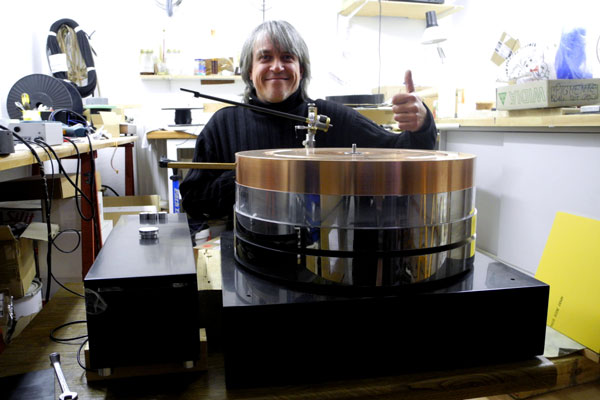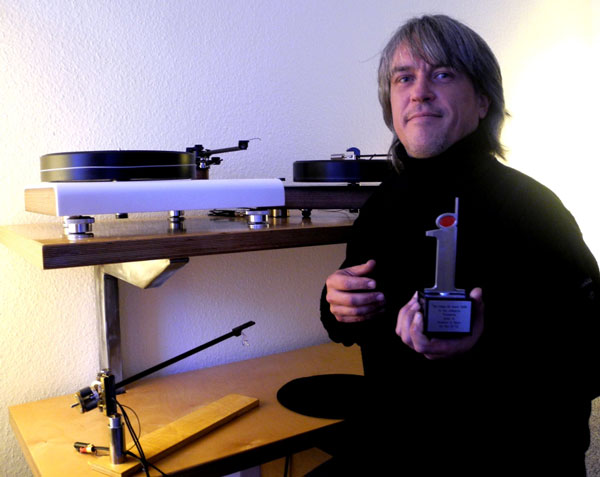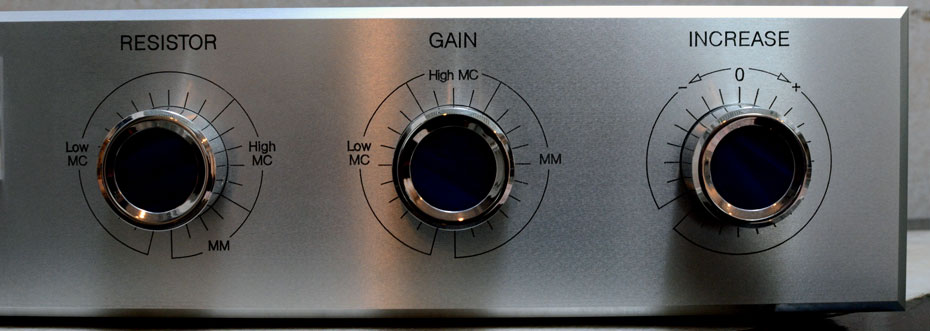With his family’s precision engineering and machining background, Christoph began his own journey of finding the best sound by building his own analog equipment. In 1999, Rossner and Sohn released their first commercial turntable. The latest special custom-made turntable is called “The Mott” (The Mother of Turntable). The rotating platter itself weighs 232 kg, and the combined unit weighs over 325 kg. Two versions of “The Mott” are available, one with oil bearing and manual adjustment (48,000€), and the full version with automatic pneumatic adjustment and air bearing (135,000€) In 2008, Rossner and Sohn won the Image Hi Fi Award for the Si 1.2 tonearm.
The Technical Details
According to Christoph, the Canofer-S phono was the result of four years of research and development, and was released in 2004. In his own words, he wanted to design a unit suitable for analog “freaks like himself,” and by freakishness he meant the need to satisfy his demand for the utmost flexibility in terms of gain and resistance loading selection. This is exactly what the Canofer-S will give you. On the front panel of the Canofer-S, you will find three rotary turn dials labeled RESISTOR, GAIN, and INCREASE. Rather than having to mess around with low quality computer grade dip switches under the hood, the Canofer-S allows you to adjust the resistance loading, gain and low frequency sensitivity on the fly, all readily accessible from the front panel. All three dials are made of chrome plated, machined solid metal. The letterings on the front panels are indented into the aluminum before a layer of black paint covers the indentation. They do not rub off easily.
The knobs include an inlay made from cobalt blue Murano Glass and they are hand polished
The RESISTOR dial allows you to optimize loading for your cartridge with 24 different settings, from 22 Ohm all the way up to 75k Ohm. The GAIN dial allows you to adjust gain from 40 dB up to 60 dB in 24 step increments. This is all very confusing at first because the owner’s menu does not explain which position correspond to which loading or gain setting choice. And to complicate things further, the menu does not fully explain what the Increase dial is to be used for. If you do the math, with 24 positions on each rotary dial, the possible combinations comes out to 13,842! With five cartridges on hand, does this mean I have to experiment with 69,210 combinations? According to Christoph, the actual number of combinations is 1,800 per cartridge rather than 13,842. But regardless, the thought of having to fiddle around with any more than 10 combination is enough to give me a headache.
Rather than messing around with all those possible combinations for each of the cartridges, I decided to contact Christoph for detailed instructions. Over the course of three weeks, we must have exchanged over thirty emails and phone calls, which not only increased my understanding of analog as a whole, but also greatly enhanced our friendship. He walked me through the entire process and according to Christoph, the resistor values are withheld on purpose, as users are encouraged to experiment with the dials and let their ears be the final judge of dial positions as opposed to a calculated number. But for those of you, who like me want to begin with doing things by the book or to avoid 13,842 possible combinations, here’s a short cut to audio nirvana, i.e., the “Gain & Loading table”:
RESISTOR (from Left to Right, in Ω or kOhm): 22 Ω – 33 – 47 – 75 – 130 – 220 – 330- 470 – 680 – 820 – 1.0 kΩ – 1.2 – 1.5 – 2.2 – 3.0 – 4.7- 6 – 8 – 10 – 15 – 22 – 47 – 75
Gain (from Left to Right, , in Ω or kOhm): 18 – 22-27 – 33 – 39-47 – 56 – 68-82 – 100 – 120-150 – 180 – 220-270 – 330 – 390-470 – 560-680 – 820 well as 1 – 1.2 to 1.5 kΩ, which essentailly corresponds to a gain of 60db on the far left down to 40 db on the far right.
The INCREASE dial on the far right of the front panel does require a bit more explanation. According to Christoph, the INCREASE dial is not an equalizer or a subsonic filter. Under no circumstances would he affect the purity of the signal through an equalizer as it would be a violation of his design principles. Turning the INCREASE dial to the “+” direction will not necessarily increase bass performance, and vice versa for the “-“ direction.
Rather, the INCREASE dial is designed to allow user to fine-tune the unit’s “sensitivity” to the unwanted resonant frequencies generated by the cartridge’s cantilever should you happen to have a tonearm that was improperly matched with the cartridge’s compliance value. As you may recall, the cantilever of every cartridge will generate unwanted resonant frequencies. This resonant frequency is dependent on the compliance of the cartridge, the weight of the tonearm, the VTF (Vertical tracking force), and the weight of the cartridge. The goal is to match your cartridge with the right tonearm so that the resultant resonant frequency will fall below the human hearing range, but not so low that it becomes affected by natural external vibrations. The ideal range is between 8 Hz and 12 Hz, but if you happen to have a tonearm/cartridge mismatch, the INCREASE dial on the Canofer-S will allow you to adjust the unit’s sensitivity to these unwanted frequencies.
- ← Previous page
- (Page 2 of 6)
- Next page →



